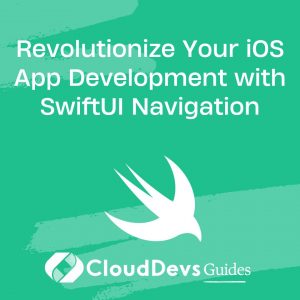Revolutionize Your iOS App Development with SwiftUI Navigation
Navigation in an iOS app is a crucial part of providing a smooth and intuitive user experience. Whether it’s tapping a button to move to a new screen, or swiping to navigate through a carousel of images, efficient navigation patterns can significantly boost the usability and popularity of an app. SwiftUI, Apple’s UI toolkit, provides a suite of powerful tools to skilled Swift developers for constructing complex navigation flows in a straightforward and effective way. By choosing to hire Swift developers, you’re ensuring that your app utilizes these robust tools for optimal navigation. This blog post will explore how to build seamless app flows using SwiftUI Navigation, enriched with practical examples, providing an insight into the advanced skills of Swift developers.
Table of Contents
1. What is SwiftUI Navigation?
SwiftUI is a robust, declarative UI framework from Apple, introduced in 2019, which helps developers design and compose user interfaces across all Apple platforms by defining their UI’s behavior and structure. One of its key features is SwiftUI Navigation, a mechanism to seamlessly transition between views in an app.
SwiftUI Navigation simplifies the creation of app interfaces with its inbuilt navigation views and modifiers, providing clean, maintainable, and easy-to-read code. However, grasping these concepts requires a good understanding of its three core components: NavigationView, NavigationLink, and @EnvironmentObject.
- NavigationView: A SwiftUI container that presents other views within a navigation context.
- NavigationLink: A SwiftUI view that establishes a destination for user-triggered navigation.
- @EnvironmentObject: A property wrapper type that lets SwiftUI views refer to shared data owned by a parent or ancestor view.
2. Building SwiftUI Navigation: Simple Stack Navigation
Let’s start with a straightforward example, a two-screen app, where a user taps a button on the first screen (HomeView) to navigate to the second screen (DetailView). We’ll use the SwiftUI NavigationView and NavigationLink components.
```swift
struct HomeView: View {
var body: some View {
NavigationView {
VStack {
Text("Home Screen")
NavigationLink(destination: DetailView()) {
Text("Go to Detail")
.font(.title)
.padding()
.background(Color.blue)
.foregroundColor(.white)
.cornerRadius(10)
}
}
.navigationBarTitle("Home")
}
}
}
struct DetailView: View {
var body: some View {
Text("Detail Screen")
.navigationBarTitle("Detail")
}
}
```
In the above code, we create a `NavigationView` in our `HomeView`. Inside this, we have a `NavigationLink` with a text button. When this button is clicked, it leads us to the `DetailView`.
3. Building Hierarchical Navigation with SwiftUI
SwiftUI makes it easy to create more complex, hierarchical navigation structures, like the one often seen in settings of iOS apps. Let’s expand on our example above:
```swift
struct HomeView: View {
var body: some View {
NavigationView {
List {
NavigationLink(destination: DetailView()) {
Text("Option 1")
}
NavigationLink(destination: DetailView()) {
Text("Option 2")
}
NavigationLink(destination: DetailView()) {
Text("Option 3")
}
}
.navigationBarTitle("Home")
}
}
}
```
Here we replaced our VStack with a List. Each list item is a NavigationLink, which will take the user to the `DetailView` when tapped.
4. Sharing Data Across Views with SwiftUI
Apps often require sharing data across multiple screens. SwiftUI’s `@EnvironmentObject` is a powerful tool for this. Let’s say we have a User object that we want to share across screens.
```swift
class User: ObservableObject {
@Published var name: String
init(name: String) {
self.name = name
}
}
```
We can provide this User object to our views using the `.environmentObject` modifier:
```swift
struct ContentView: View {
var body: some View {
HomeView()
.environmentObject(User(name: "John Doe"))
}
}
```
And we can access it in our `HomeView` and `DetailView` like this:
```swift
struct HomeView: View {
@EnvironmentObject var user: User
var body: some View {
//...
}
}
struct DetailView: View {
@EnvironmentObject var user: User
var body: some View {
//...
}
}
```
5. NavigationView Modifiers in SwiftUI
SwiftUI also provides us with modifiers to change the behavior and appearance of our navigation views. For instance, the `.navigationBarTitleDisplayMode` modifier allows us to change the display mode of the title in a navigation bar. There are three modes available: `.large`, `.inline`, and `.automatic`.
```swift
NavigationView {
//...
}
.navigationBarTitle("Home", displayMode: .large)
```
Another useful modifier is the `.navigationBarItems` modifier. It lets us add buttons or other views to the navigation bar. Here’s how we can add a button that triggers a print statement when tapped:
```swift
NavigationView {
//...
}
.navigationBarItems(trailing:
Button(action: {
print("Button tapped!")
}) {
Text("Tap Me!")
}
)
```
Conclusion
Building intuitive navigation in your iOS app is crucial for a smooth user experience. SwiftUI Navigation, a powerful tool often mastered by adept Swift developers, offers a straightforward mechanism for navigating between views and sharing data. By understanding its core components – NavigationView, NavigationLink, and @EnvironmentObject – developers can efficiently build complex navigation flows. Furthermore, the various navigation modifiers available can assist Swift developers in creating a more customized and user-friendly interface. As SwiftUI continues to evolve, more tools and features are being introduced, making the task of hiring Swift developers an investment for more accessible and enjoyable iOS app development.
Table of Contents









